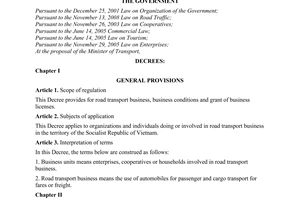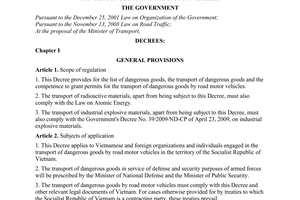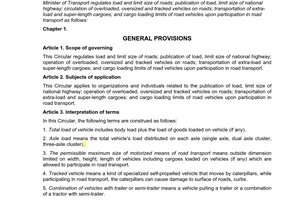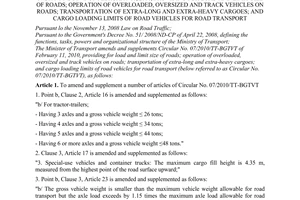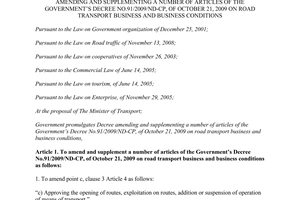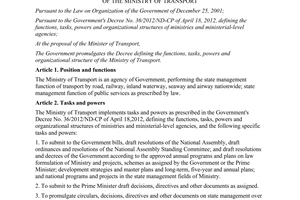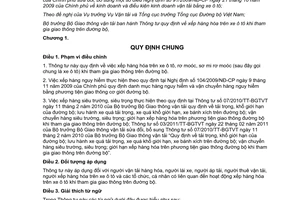Nội dung toàn văn Circular No. 35/2013/TT-BGTVT stowage of goods onto road motor vehicles
|
MINISTRY OF
TRANSPORT |
SOCIALIST
REPUBLIC OF VIETNAM |
|
No. 35/2013/TT-BGTVT |
Hanoi, October 21, 2013 |
CIRCULAR
STOWAGE OF GOODS ONTO ROAD MOTOR VEHICLES
Pursuant to the Law on Road traffic dated November 12, 2008;
Pursuant to the Government's Decree No. 107/2012/ND-CP dated December 20, 2012, defining the functions, tasks, entitlements and organizational structure of the Ministry of Transport;
Pursuant to the Government's Decree No. 91/2009/ND-CP dated October 21, 2009 on road transport business; the Government's Decree No. 93/2012/ND-CP dated November 08, 2012 on amendments to the Government's Decree No. 91/2009/ND-CP;
At the request of the Director of Transport Administration and the Director of Directorate for Roads of Vietnam;
The Minister of Transport promulgates a Circular on stowage of goods onto road motor vehicles
Chapter 1.
GENERAL PROVISIONS
Article 1. Scope
1. This Circular deals with the stowage of goods onto motor vehicles, trailers, semi-trailers (hereinafter referred to as motor vehicles) that use the road.
2. Dangerous goods shall be stowed in accordance with the Government's Decree No. 104/2009/ND-CP dated November 09, 2009 on the list of dangerous goods and transport of dangerous goods by road motor vehicles.
3. Oversize cargo shall be stowed in accordance with the Circular No. 07/2010/TT-BGTVT dated February 11, 2010 of the Minister of Transport on load capacities of road, dimensional limits of roads; operation of overloaded vehicles, overdimension vehicles, and tracked vehicles on the road, transport of oversize cargo, and limits of goods stowed onto road motor vehicles; the Circular No. 03/2011/TT-BGTVT dated February 22, 2011 of amendments to the Circular No. 07/2010/TT-BGTVT.
Article 2. Subjects of application
This Circular is applied to couriers, drivers, escorts, hirers, cargo handlers, and the entities involved in the stowage of goods onto motor vehicles.
Article 3. Interpretation of terms
In this Circular, the terms below are construed as follows:
1. Courier means an organization or individual that uses motor vehicles to transport goods on the road.
2. Road transport business means a company, cooperative, or business household that engages in the business of road transport of goods.
3. Cargo handler means the organization or individual that loads goods onto motor vehicles.
4. Hirer means an organization or individual that hires a road transport business to transport goods by road motor vehicles.
5. Bulk cargo means the cargo in granular or particulate form and can be transported unpacked in the cargo box of the motor vehicle.
6. Packaged cargo means goods that are contained in packages or boxes to ensure they are not leaked or damaged during the transport.
7. Cylindrical objects mean goods in the shape of a cylinder or a tube that can easily roll over a flat surface.
8. Container means a sustainable and sturdy part of a means of transport which can be used multiple times and allows for convenient handling, especially when being moved from one mode of transport to another. Containers are designed and manufactured under applied standards.
Chapter 2.
REGULATIONS ON STOWING GOODS ONTO ROAD MOTOR VEHICLES
Article 4. General rules for stowing goods
1. The courier must select a vehicle that suits the type of goods being transported.
2. The stowage and transport of goods must comply with regulations on design capacities of motor vehicles, load capacities and dimensional limits of bridges, tunnels, and roads; comply with regulations on traffic safety and environmental safety.
3. If goods are machinery, fuel must be removed from the vehicle before goods are stowed.
4. Goods must be so stowed onto the vehicle that weight is distributed evenly. Do not place goods at only one side. Goods must be secured so that then would not be displaced during the transit.
Article 5. Stowage of bulk cargo
1. Bulk cargo must be transported by a truck with a cargo box or container.
2. If bulk cargo is transported with a truck without a closed box, the courier must cover the goods so that they would not be spilled during the transport.
3. The instructions on covering bulk cargo are illustrated in Appendix 1 of this Circular.
Article 6. Stowage of packaged cargo
1. Heavy packages with hard and steady covers shall be placed at the bottom.
2. Packages similar in sizes shall be placed together.
3. Packages that tend to slightly tilt shall be placed at the middle of the pile.
4. Any gaps between the packages must be filled to avoid collision and displacement in transit. The cargo must be secured if there is still unused space in the cargo box after all goods are stowed.
Article 7. Stowage of cylindrical objects
1. Cylindrical objects shall be stowed with their axis across or along the length of the vehicle depending on the ratio of its length to the length of the cargo box.
2. If the height of a cylinder is smaller than the diameter, it must be placed upright.
3. Cylindrical objects must be secured to the side of the vehicle or be choked with wedges or blocks to avoid displacement during the transport.
4. If cylindrical objects with smooth surface are stacked up, there must be padding between the layers to avoid sliding
5. The instructions on stowing and securing cylindrical objects are illustrated in Appendix 2 of this Circular.
Article 8. Stowage of goods in containers and loading containers onto motor vehicles
1. Stowage of goods in containers:
a) The container must be suitable for the characteristics of the goods being;
b) Goods inside the container must be choked to avoid displacement during transport;
c) The maximum weights of containers and goods therein are specified in ISO 668 on classifications, dimensions, and nominal weights.
2. Containers must be transported with a tractor-trailer or a container truck that suits the type of containers.
3. Devices shall be used to align the container with the vehicle to ensure that the container is not displaced during transport;
Chapter 3.
RESPONSIBILITIES OF RELEVANT ENTITIES
Article 9. Responsibilities of couriers, drivers, and escorts
1. The courier must:
a) Update info about the load capacities, dimensional limits of bridges, tunnels, and roads along the route before commencing the transport;
b) Use the vehicles that suit the goods being transport, the load capacities, dimensional limits of bridges, tunnels, and roads along the route;
c) Provide the driver, the escort, and the cargo holder with information about the characteristics of goods, dimensions and weights of goods and packages, capacity of the vehicle, load capacities, dimensional limits of bridges, tunnels, and roads along the route; take responsibility for the provided information;
d) Provide sufficient instruments for covering, securing, and padding goods in order for the cargo handlers to adhere to the regulations on stowage of goods;
dd) Provide instructions on cargo loading for drivers and escorts;
e) Take responsibility for every violation against regulations on load capacities, dimensional limits, and stowage of goods onto motor vehicles;
g) Reimburse the driver, escort, or cargo handle for the fine they get when violating regulations on stowage of goods at the request of the courier.
2. Responsibilities of drivers and escorts:
a) Provide instructions and cooperate with the cargo handlers in stowing, covering, securing, and choking goods;
b) Compare the goods on the vehicle and information provided by the courier to ensure the weight does not exceed the load capacities and dimensional limits of the bridges, tunnels, and roads along the route before beginning the transport;
c) The driver is responsible for transporting goods in the knowledge that they violate regulations on load capacities, dimensional limits, and other regulations on stowage of goods.
Article 10. Responsibilities of the hirer
Provide the courier with information about the characteristics, dimensions, and weight of goods and packages; take responsibility for the provided information.
Article 11. Responsibilities of cargo handlers
1. Receive information from the courier to stow goods onto the vehicles properly.
2. Do not exceed the capacity of the vehicle, the load capacities, dimensional limits of bridges, tunnels, and roads along the route.
3. Cover, secure, and choke goods properly; comply with regulations and instructions of the driver and the escort.
4. Take responsibility for violations against regulations on stowage of goods, unless such violations are proved to be requested by the courier, or on account of incorrect information.
Article 12. Responsibilities of Directorate for Roads of Vietnam
1. Take charge and cooperate with Vietnam Road Transport Association in providing training and instructions on the implementation of this Circular.
2. Carry out inspections and punish the violations against this Circular.
3. Monitor and report the implementation of this Circular to the Ministry of Transport for timely amendments.
Article 13. Responsibilities of Provincial Services of Transport
1. Take charge and cooperate with local Road Transport Associations in providing training and instructions on the implementation of this Circular locally.
2. Carry out inspections and punish the violations against this Circular.
Chapter 4.
IMPLEMENTATION
Article 14. Effect
This Circular takes effect on December 15, 2013.
Article 15. Responsibility for implementation
Chief of the Ministry Office, Chief Inspector of the Ministry, Directors of Departments, Director of Directorate for Roads of Vietnam, Director of Provincial Services of Transport, heads of relevant organizations, and individuals concerned are responsible for the implementation of this Circular./.
|
|
MINISTER |
APPENDIX 1
STOWING AND COVERING BULK CARGO
|
|
|
|
Improperly stowed bulk cargo |
Properly stowed bulk cargo |
|
|
|
|
Bulk cargo is covered with canvas |
Bulk cargo is covered with wire mesh |
APPENDIX 2
LOADING AND SECURING CYLINDRICAL CARGO
|
|
|
|
The rolls are vertically stowed and secured on the platform |
The rolls are stowed and secured with their axis across the vehicle |
|
|
|
|
The cylindrical pipes are stowed and secured with wedge beds |
Cylinders are stowed and secured with their axis across the vehicle |
|
|
|
|
Long and big cylinders are stowed and secured |
Heavy cylinders horizontally stowed and secured along the platform |
|
|
|
|
Long pipes are stowed and secured in a closed box |
Long pipes are secured to each other and to the platform |













